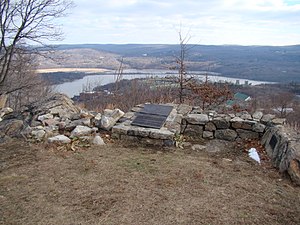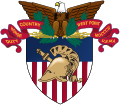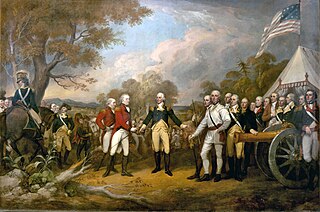
The Battles of Saratoga marked the climax of the Saratoga campaign, giving a decisive victory to the Americans over the British in the American Revolutionary War. British General John Burgoyne led an invasion army of 7,200-8,000 men southward from Canada in the Champlain Valley, hoping to meet a similar British force marching northward from New York City and another British force marching eastward from Lake Ontario; the goal was to take Albany, New York. The southern and western forces never arrived, and Burgoyne was surrounded by American forces in upstate New York 15 miles (24 km) short of his goal. He fought two battles which took place 18 days apart on the same ground 9 miles (14 km) south of Saratoga, New York. He gained a victory in the first battle despite being outnumbered, but lost the second battle after the Americans returned with an even larger force.
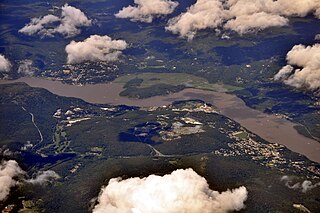
West Point is the oldest continuously occupied military post in the United States. Located on the Hudson River in New York, West Point was identified by General George Washington as the most important strategic position in America during the American Revolution. Until January 1778, West Point was not occupied by the military. On January 27, 1778, Brigadier General Samuel Holden Parsons and his brigade crossed the ice on the Hudson River and climbed to the plain on West Point and from that day to the present, West Point has been occupied by the United States Army. It comprises approximately 16,000 acres (6,500 ha) including the campus of the United States Military Academy, which is commonly called "West Point".

Andrzej Tadeusz Bonawentura Kościuszko was a Polish military engineer, statesman, and military leader who became a national hero in Poland, Lithuania, Belarus, France and the United States. He fought in the Polish–Lithuanian Commonwealth's struggles against Russia and Prussia, and on the US side in the American Revolutionary War. As Supreme Commander of the Polish National Armed Forces, he led the 1794 Kościuszko Uprising.
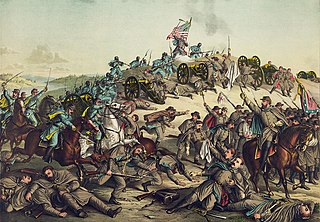
The Battle of Nashville was a two-day battle in the Franklin-Nashville Campaign that represented the end of large-scale fighting west of the coastal states in the American Civil War. It was fought at Nashville, Tennessee, on December 15–16, 1864, between the Confederate Army of Tennessee under Lieutenant General John Bell Hood and the Union Army of the Cumberland under Major General George H. Thomas. In one of the largest victories achieved by the Union Army during the war, Thomas attacked and routed Hood's army, largely destroying it as an effective fighting force.

The Battle of Stony Point took place on July 16, 1779, during the American Revolutionary War. In a well-planned and -executed nighttime attack, a highly trained select group of George Washington's Continental Army troops under the command of Brigadier General "Mad Anthony" Wayne defeated British troops in a quick and daring assault on their outpost in Stony Point, New York, approximately 30 mi (48 km) north of New York City.

Fort Pickens is a pentagonal historic United States military fort on Santa Rosa Island in the Pensacola, Florida, area. It is named after American Revolutionary War hero Andrew Pickens. The fort was completed in 1834 and was one of the few forts in the South that remained in Union hands throughout the American Civil War. It remained in use until 1947. Fort Pickens is included within the Gulf Islands National Seashore, and as such, is administered by the National Park Service.

The Western Heights of Dover are one of the most impressive fortifications in Britain. They comprise a series of forts, strong points and ditches, designed to protect the country from invasion. They were created in the 18th and 19th centuries to augment the existing defences and protect the key port of Dover from both seaward and landward attack; by the start of the 20th century Dover Western Heights was collectively reputed to be the 'strongest and most elaborate' fortification in the country. The Army finally withdrew from the Heights in 1956–61; they are now a local nature reserve.

The Gin Drinkers Line, or Gin Drinkers' Line, was a British military defensive line against the Japanese invasion of Hong Kong during the Battle of Hong Kong in December 1941, part of the Pacific War.

A redoubt is a fort or fort system usually consisting of an enclosed defensive emplacement outside a larger fort, usually relying on earthworks, although some are constructed of stone or brick. It is meant to protect soldiers outside the main defensive line and can be a permanent structure or a hastily constructed temporary fortification. The word means "a place of retreat". Redoubts were a component of the military strategies of most European empires during the colonial era, especially in the outer works of Vauban-style fortresses made popular during the 17th century, although the concept of redoubts has existed since medieval times. A redoubt differs from a redan in that the redan is open in the rear, whereas the redoubt was considered an enclosed work.
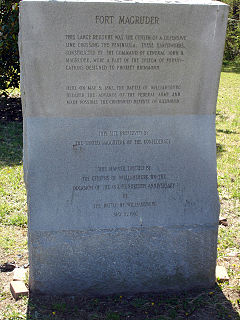
Fort Magruder was a 30-foot (9.1 m) high earthen fortification straddling the road between Yorktown and Williamsburg, Virginia, just outside the latter city during the American Civil War. At the center of the Williamsburg Line, it was also referred to as Redoubt Number 6.

The Battle of Fort Washington was fought in New York on November 16, 1776, during the American Revolutionary War between the United States and Great Britain. It was a British victory that gained the surrender of the remnant of the garrison of Fort Washington near the north end of Manhattan Island. It was one of the worst Patriot defeats of the war.
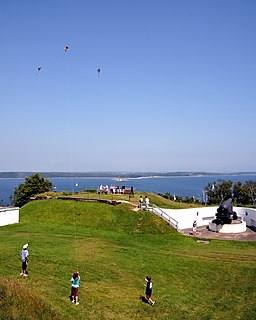
York Redoubt is a redoubt situated on a bluff overlooking the entrance to Halifax Harbour at Ferguson's Cove, Nova Scotia, Canada, originally constructed in 1793. It was designated a National Historic Site of Canada in 1962.
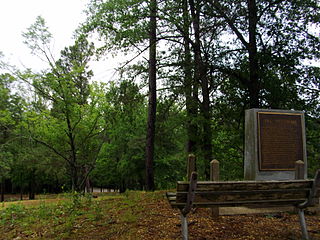
Fort Southerland, also known as Redoubt E and possibly Fort Diamond, is a redoubt built during the American Civil War to protect Camden, Arkansas. Confederate forces built it along with four other redoubts in early 1864 after a Union victory in the Little Rock campaign the previous year. Fort Southerland is about the size of a city block and is roughly oval. It could hold three cannons. When Union forces captured Camden in April 1864 during the Camden Expedition, they improved the defenses of the five redoubts, which were not sufficient for proper defense of the city. After the Confederates retook Camden later that month, they continued to improve the city's defenses.
The history of the United States Military Academy can be traced to fortifications constructed on the West Point of the Hudson River during the American Revolutionary War in 1778. Following the war, President Thomas Jefferson signed legislation establishing the United States Military Academy (USMA) on the site in 1802. In 1817 the academy was transformed by the appointment of Sylvanus Thayer who drastically reformed the curriculum.

Constitution Island is in the northeastern United States, located in New York on the east side of the Hudson River, north of New York City. It is directly opposite the U.S. Military Academy Reservation at West Point and is connected to the east shore by Constitution Marsh.

Kosciuszko's Garden is a small retreat garden built by Tadeusz Kosciuszko on the side of a cliff overlooking the Hudson River at West Point, New York. First constructed in 1778, it still offers visitors and cadets a place of quiet tranquility during the warmer months. The "General Edward L. Rowny Family Endowment" was established to further sustain perpetual care and maintenance of the Garden and to dedicate a plaque commemorating the occasion.

Fort Clinton was an American Revolutionary War fort located near West Point, New York. Commanded by and named after Benedict Arnold before his betrayal of the United States and defection to the British Army, the fortification was renamed after General James Clinton.
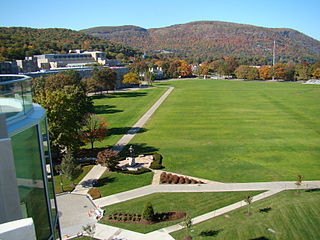
The Plain is the parade field at the United States Military Academy at West Point, New York. The flat terrain of the Plain is in contrast to the varied and hilly terrain of the remainder of the campus. The Plain rises approximately 150 feet (45 m) above the Hudson River and has been the site of the longest continually occupied U.S. Army garrison in America since 1778. In its early years, the entire academy was located on the Plain and it was used for varying activities ranging from drill and mounted cavalry maneuvers to an encampment site for summer training to a sports venue. Currently, the Plain refers to just the parade field where cadets perform ceremonial parades.
François-Louis Teissèdre de Fleury was a French nobleman who joined the Royal Army in 1768 and later volunteered to fight in the Continental Army during the American Revolutionary War. In America he demonstrated his bravery at Piscataway in May 1777 after which he was appointed an officer of engineers. He fought at the Brandywine in September and was wounded at Germantown in early October. He served capably during the Siege of Fort Mifflin where he was wounded again in November. George Washington made him an assistant to Friedrich Wilhelm von Steuben at Valley Forge in the spring of 1778. He served during the Monmouth Campaign in June 1778 and fought in Rhode Island in August.
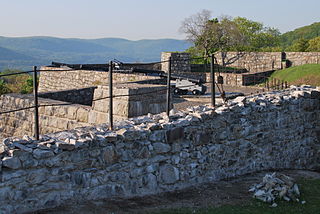
Fort Putnam was a military garrison during the Revolutionary War at West Point, New York, United States. Built by a regiment of Colonel Rufus Putnam's 5th Massachusetts Regiment, it was completed in 1778 with the purpose of supporting Fort Clinton, which sat on the edge of the Hudson River about 3/4 of a mile away. The fort was rebuilt and enlarged in 1794 before falling into disuse and disrepair as the military garrison at West Point became obsolete in the early mid-19th century. It underwent a major preservation as a historical site in 1909, and has been continually in the process of preservation since. Sitting at an altitude of 500 feet above sea level, it was West Point's largest garrison during the Revolutionary War. The Fort is under the supervision of the West Point Museum Director, David M. Reel, and is operated by the United States Army Garrison, West Point. Access to the Fort is seasonal and as summer staff are available.
